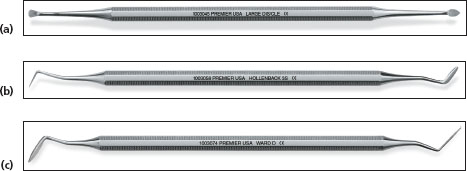SECTION 8
INSTRUMENTS USED IN BASIC RESTORATIVE PROCEDURES
Basic restorative procedures involve placement of restorations where tooth tissue has been removed for a variety of reasons (e.g. fractures and caries)
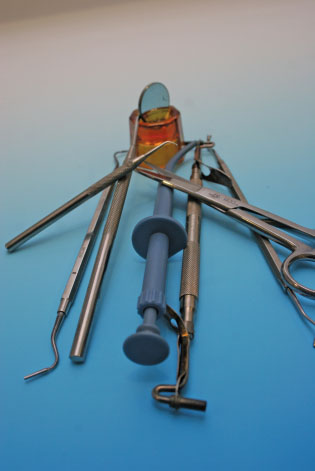




FOR ALL RESTORATIONS
FIGURES 8.1a, b; 8.2a, b; 8.3a, b
Name
Spoon excavators
Functions and feature
- A spoon-shaped working end for ‘spooning’ out dentinal caries from the cavity preparation
- Edges of working end are sharp
Any remaining caries will be removed with the conventional handpiece and a round bur
Varieties
Various sizes and shapes of working ends – can be double-ended or single-ended
False friends
Cleoid discoid carver, spoon curette, ball burnisher
FIGURES 8.4a, b; 8.5a, b
Name
Gingival margin trimmers (Figure 8.4a, b) Distal (Figure 8.5a, b) Mesial
Function and feature
- Used to remove unsupported enamel for refining the cavity preparation
- Sharp-bevelled working ends
False friends
Spoon excavator, Hollenback 3½ carver, Wards carver




FIGURE 8.6a, b
Name
Enamel chisel
Function and feature
- Used to remove unsupported enamel for refining the cavity preparation
- Sharp-bevelled working ends
Varieties
Various sizes and shapes available
False friends
Push scaler, ligature tucker
FIGURE 8.7
Name
Enamel hatchet
Function and feature
- Used to remove unsupported enamel for refining the cavity preparation
- Working end is on the same plane as the handle
Varieties
Various sizes and shapes available
False friends
Push scaler, gingival margin trimmer, enamel chisel
FIGURE 8.8a, b
Name
Disposable applicators
Function(s)
- Used to apply materials intra-orally, e.g. desensitising agents, bonding agents and cavity varnish
- 8.8b are inserted into a plastic handle
Varieties
Many different types and shapes available

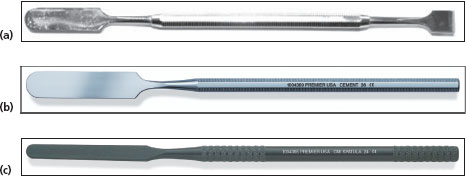
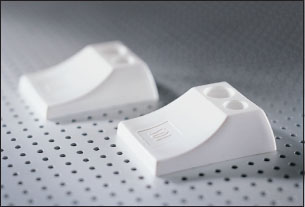
FIGURE 8.9
Name
Calcium hydroxide applicator
Function
- Used to apply calcium hydroxide and other lining materials at the base of the cavity preparation
Varieties
Different sized working ends and long handles available
FIGURE 8.10a, b, c
Name
Mixing spatulas: (a) Stainless steel Weston spatula (b) Stainless steel broad bladed spatula (c) Anodised aluminium spatula
Function and feature
- Used to mix dental materials
- Anodised aluminium spatula will not stick to any composite materials or discolour materials (Figure 8.10c)
Varieties
Different sizes, degrees of flexibility and shapes available
FIGURE 8.11
Name
Dispensing wells
Function
- Used to hold material to be dispensed (e.g. bonding agent)
Varieties
- Available in various shapes and sizes
- Available with a small orange shield over dispensing hole to protect dispensed materials from light
- Available as disposable type
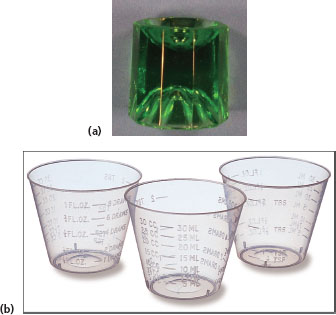

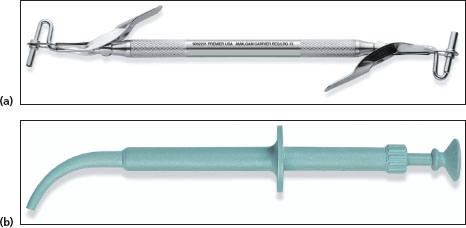
FIGURE 8.12a, b
Name
(a) Glass dappen dish (b) Disposable plastic dappen dishes
Function
To hold materials for dispensing
Varieties
Various shapes, sizes and colours available
FOR AMALGAM RESTORATIONS
FIGURE 8.13
Name
Flat plastic instrument. Also called: plastic instrument
Functions
- To deliver materials to the cavity preparation
- To remove excess materials
Varieties
- Various sizes and shapes available
- Can be single-ended or double-ended
False friends
Spoon excavator, Hollenback carver, Wards carver
FIGURE 8.14a, b
Name
(a) Metal amalgam carrier (b) Plastic amalgam carrier
Function, features and precaution
- Used to pick up, transport and place amalgam into the cavity preparation
- Working end is hollow
- A plunger/lever pushes amalgam out from working end into the cavity preparation
- The working end may be Teflon® coated so the amalgam will not stick
- Care must be taken to expel the excess amalgam or it will set inside the working end
- Sterilisation procedures may vary depending on the material that the amalgam carrier is fabricated from
Varieties
- Various delivery methods
- Various sizes of working ends for different amounts of amalgam needed
- Can be single-ended or double-ended

